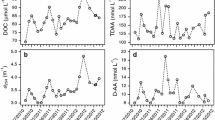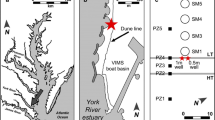Abstract
Changes in concentration ofdissolved organic carbon (DOC) reflectbiogeochemical processes that determinechemical composition of groundwater and othernatural waters. We found that the deeper thevadose zone, the lower the concentration of DOCin groundwater near the water table, indicatingthat considerable attenuation ofsurface-derived DOC occurred in the vadosezone. Under vadose zones <1.25 m, DOCconcentrations at the surface of the watertable ranged to >20 mg C l−1, while forvadose zones >5.0 m, DOC never exceeded2.0 mg C l−1. DOC concentrations alsodecreased exponentially with increasing depthbelow the water table, most notably in theupper two meters, implying continuedattenuation in the upper layer of the saturatedzone. Ninety-nine percent of the DOC wasattenuated by the time the water reached adepth of 19 m below the water table. A stronginverse relationship between DOC and nitrateconcentrations suggests that nitrate isdepleted where DOC supplies are high, providingevidence that some portion of the DOC losses ingroundwater are due to microbialtransformations, including denitrification. DOC concentrations in shallow groundwater showconsiderable spatial variability, butconcentration of DOC at any one site issurprisingly stable over time. The largestsource of variation in DOC concentration ingroundwater therefore is spatial rather thantemporal, suggesting that local heterogeneitiesplay an important role in DOC delivery toshallow groundwater. Our results highlightboth the importance of shallow vadose areas inDOC delivery to groundwater and the need todistinguish where samples are collected inrelation to flow paths before conclusions aremade about mean groundwater DOC concentrations. The substantial losses of DOC in the vadosezone and in shallow depths within the aquifersuggest quite active biogeochemical processesin these boundary environments.
Similar content being viewed by others
References
Aelion CM,Shaw JN &Wahl M (1997) Impact of suburbanization on ground water quality and denitrification in coastal aquifer sediments. J. Exper. Mar. Biol. Ecol. 213: 31–51
Baker MA,Valett HM &Dahm CN (2000) Organic carbon supply and metabolism in a shallow groundwater ecosystem. Ecol. 81: 3133–3148
Barber LB II (1991) Effects of particle size and mineralogy on sorption of nonionic organic solutes to glacial outwash sediments, Cape Cod, Massachusetts. U.S. Geological Survey Toxic Substances Hydrology Program: Proceedings of the Technical Meeting, Monterey, California, March 11-15. U.S. Geological Survey, Water-Resources Investigations Report 91–4034
Barcelona MJ (1984) TOC determination in groundwater. Ground Water 22: 18–24
Barlow PM &Hess KM (1993) Simulated Hydrologic Responses of the Quashnet River Stream-Aquifer System to Proposed Ground-Water Withdrawals, Cape Cod, Massachusetts. U.S. Geological Survey, Water-Resources Investigations Report 93-4-64, Marlborough
Bryan BA (1981) Physiology and biochemistry of denitrification. In: Delwiche CC (Ed) Denitrification, Nitrification, and Atmospheric Nitrous Oxide (pp 67–84 ). Wiley, New York
Cambareri TC &Eichner EM (1998) Watershed delineation and ground water discharge to a coastal embayment. Ground Water 36: 626–634
Chapelle FH (1992) Ground-Water Microbiology and Geochemistry. JohnWiley & Sons, Inc., New York
Clay DE,Clay SA,Moorman TB,Brix-Davis K,Scholes KA &Bender AR (1996) Temporal variability of organic C and nitrate in a shallow aquifer. Water Res. 30: 559–568
Cronan CS &Aiken GR (1985) Chemistry and transport of soluble humic substances in forested watersheds of the Adirondack Park, New York. Geochim. Cosmochim. Acta 49: 1697–1705
Davis JA (1982) Adsorption of natural dissolved organic matter at the oxide/water interface. Geochim. Cosmochim. Acta 46: 2381–2393
Easthouse KB,Mulder J,Christophersen N &Seip HM (1992) Dissolved organic carbon fractions in soil and stream water during variable hydrological conditions at Birkenes, Southern Norway. Water Resources Res. 28: 1585–1596
Ellis B,Stanford JA &Ward JV (1998) Microbial assemblages and production in alluvial aquifers of the Flathead River, Montana, U.S.A. J. N. Am. Benthol. Soc. 17: 382–402
Ford T &Naiman RJ (1989) Groundwater-surface water relationships in boreal forest watersheds: Dissolved organic carbon and inorganic nutrient dynamics. Can. J. Fish. Aquat. Sci. 46: 41–49
Hakenkamp C,Palmer MA &James BR (1994) Metazoans from a sandy aquifer: Dynamics across a physically and chemically heterogeneous groundwater system. Hydrobiol. 287: 195–206
Hendricks S &White DS (1995) Seasonal biogeochemical patterns in surface water, subsurface hyporheic, and riparian ground water in a temperate stream ecosystem. Arch. Hydrobiol. 134: 459–490
Hill AR,Devito KJ,Campagnolo S &Sanmugadas K (2000) Subsurface denitrification in a forest riparian zone: Interactions between hydrology and supplies of nitrate and organic carbon. Biogeochem. 51: 193–223
Jordan TE,Correll DL &Weller DE (1997) Relating nutrient discharges from watersheds to land use and streamflow variability. Water Resources Res. 33: 2579–2590
Keller C (1991) Hydrogeochemistry of a clayey till 2. Sources of CO2. Water Resources Res. 27: 2555–2564
Kookana RS &Naidu R (1998) Vertical heterogeneity in soil properties and contaminant transport through soil profiles. In: P Dillon & Simmers I (Eds) International Contributions to Hydrology 18: Shallow Groundwater Systems (pp 15–28 ). A.A. Balkema, Rotterdam
Lawrence GB,Driscoll CT &Fuller RD (1988) Hydrologic control of aluminum chemistry in an acidic headwater stream. Water Resources Res. 24: 659–669
LeBlanc DR (1984) Sewage Plume in a Sand and Gravel Aquifer, Cape Cod, Massachusetts. U.S. Geological Survey, Water-Supply Paper 2218, Washington
LeBlanc DR,Garabedian SP,Hess KM,Gelhar LW,Quadri RD,Stollenwerk KG &Wood WW (1991) Large-scale natural gradient tracer test in sand and gravel, Cape Cod, Massachusetts 1. Experimental design and observed tracer movement. Water Resources Res. 27: 895–910
LeBlanc DR,Guswa JH,Frimpter MH &Londquist CJ (1986) Ground-water resources of Cape Cod, Massachusetts, U.S. Geological Survey Hydrologic Atlas 692
Leenheer J,Malcolm RL,McKinley PW &Eccles LA (1974) Occurrence of dissolved organic carbon in selected ground-water samples in the United States. J. Res. U.S. Geol. Survey 2: 361–369
Lind A &Eiland F (1989) Microbial characterization and nitrate reduction in subsurface soils. Biol. Fert. Soils 8: 197–203
Masterson JP,Walter DA &Savoie J (1997) Use of Particle Tracking to Improve Numerical Model Calibration and to Analyze Ground-Water Flow and Contaminant Migration. Massachusetts Military Reservation, Western Cape Cod, Massachusetts, USGS W 2482, 50 pp.
McCarty GW &Bremner JM (1992) Availability of organic carbon for denitrification of nitrate in subsoils. Biol. Fert. Soils 14: 219–222
McDowell WH &Likens GE (1988) Origin, composition, and flux of dissolved organic carbon in the Hubbard Brook Valley. Ecol. Monogr. 58: 177–195
Mulder J,Christophersen N,Hauhs M,Vogt RD,Andersen S &Andersen DO (1990) Water flow paths and hydrochemical controls in the Birkenes catchment as inferred from a rainstorm high in seasalts. Water Resources Res. 26: 611–622
Neal C,Reynolds B,Stevens P &Hornung M (1989) Hydrogeochemical controls for inorganic aluminium in acid stream and soil waters at two upland catchments in Wales. J. Hydrol. 106: 155–175
Obenhuber D &Lowrance R (1991) Reduction of nitrate in aquifer microcosms by carbon additions. J. Environ. Qual. 20: 255–258
Pabich WJ (2001) Denitrification of Anthropogenic Nitrogen in Groundwater: Measurement and Modeling Using Stable Isotopic and Mass Balance Approaches. PhD thesis, Massachusetts Institute of Technology, Cambridge, MA, 188 pp
Parfitt RL,Fraser AR,Russell JD &Farmer VC (1977) Adsorption on hydrous oxides. II. Oxalate, benzoate and phosphate on gibbsite. J. Soil. Sci. 28: 40–47
Parkin TB &Meisinger JJ (1989) Denitrification below the crop rooting zone as influenced by surface tillage. J. Environ. Qual. 18: 12–16
Parlange J-Y,Steenhuis TS,Haverkamp R,Barry DA,Culligan PJ,Hogarth WL,Parlange MB,Ross P &Stagnitti F (1999) Soil properties and water movement. In: Parlange MB & JW Hopmans (Eds) Vadose Zone Hydrology. Oxford University Press, New York
Portniaguine O &Solomon DK (1998) Parameter estimation using groundwater age and head data, Cape Cod, Massachusetts. Water Resources Res. 34: 637–645
Rutherford J &Hynes HBN (1987) Dissolved organic carbon in streams and groundwater. Hydrobiologia 154: 33–48
Savoie J &LeBlanc DR (1998) Water-Quality Data and Methods of Analysis for Samples Collected Near a Plume of Sewage-Contaminated Ground Water, Ashumet Valley, Cape Cod, Massachusetts, 1993-1994. U.S. Geological Survey, Marlborough
Schiff SE,Aravena R,Trumbore SE &Dillon PJ (1990) Dissolved organic cycling in forested watersheds: A carbon isotope approach. Water Resources Res. 26: 2949–2957
Schiff SL,Aravena R,Trumbore SE,Hinton MJ,Elgood R &Dillon PJ (1997) Export of DOC from forested catchments on the Precambrian Shield of Central Ontario: Clues from 13C and 14C. Biogeochem. 36: 43–65
Schindler J &Krabbenhoft DP (1998) The hyporheic zone as a source of dissolved organic carbon and carbon gases to a temperate forested stream. Biogeochem. 43: 157–174
Schlosser P,Stute M,Dorr H,Sonntag C &Munnich KO (1988) Tritium/3He dating of shallow groundwater. Earth Planet. Sci. lett. 89: 352–363
Seely B,Lajtha K &Salvucci GD (1998) Transformation and retention of nitrogen in a coastal forest ecosystem. Biogeochem. 42: 325–343
Sholkovitz ER &Copland D (1982) The chemistry of suspended matter in Esthwaite Water, a biologically productive lake with seasonally anoxic hypolimnion. Geochim. Cosmochim. Acta 46: 393–410
Smith RL,Howes BL &Duff JH (1991) Denitrification in nitrate-contaminated groundwater: Occurrence in steep vertical geochemical gradients. Geochim. Cosmochim. Acta 55: 1815–1825
Sokal RR &Rohlf FJ (1995) Biometry: The Principles and Practice of Statistics in Biological Research. W.H. Freeman and Company, New York
Solomon DK,Poreda RJ,Cook PG &Hunt A (1995) Site characterization using 3H/3He ground-water ages, Cape Cod, MA. Ground Water 33: 988–996
Solomon DK,Poreda RJ,Schiff SL &Cherry JA (1992) Tritium and helium-3 as groundwaterage tracers in the Borden Aquifer. Water Resources Res. 29: 2951–2962
Stollenwerk KG (1996) Simulation of phosphate transport in sewage-contaminated groundwater, Cape Cod, Massachusetts. Appl. Geochem. 11: 317–324
Sullivan TJ,Christopherson N,Muniz IP,Seip HM &Sullivan PD (1986) Aqueous aluminium chemistry response to episodic increases in discharge. Nature 323: 324–327
Thurman EM (1985) Organic Geochemistry of Natural Waters. Martinus Nijhoff/DRW. Junk Publishers, Dordrecht
Tipping E,Woof C &Cooke D (1981) Hydrous iron oxide from a seasonally anoxic lake. Geochim. Cosmochim. Acta 46: 75–80
Valiela I,Collins G,Kremer J,Lajtha K,Geist M,Seely B,Brawley J &Sham CH (1997) Nitrogen loading from coastal watersheds to receiving estuaries: New method and application. Ecol. Appl. 7: 358–380
Vogel JC (1967) Investigation of groundwater flow with radiocarbon. In: Isotopes in Hydrology (pp 355–369 ). IAEA-SM-83/24, Vienna
Wan J &Tokunaga TK (1997) Film straining of colloids in unsaturated porous media: Conceptual model and experimental testing. Environ. Sci. Technol. 31: 2413–2420
Author information
Authors and Affiliations
Corresponding author
Rights and permissions
About this article
Cite this article
Pabich, W.J., Valiela, I. & Hemond, H.F. Relationship between DOC concentration and vadose zone thickness and depth below water table in groundwater of Cape Cod, U.S.A.. Biogeochemistry 55, 247–268 (2001). https://doi.org/10.1023/A:1011842918260
Issue Date:
DOI: https://doi.org/10.1023/A:1011842918260




